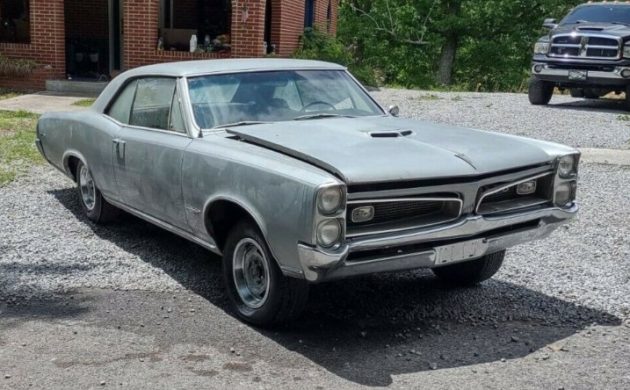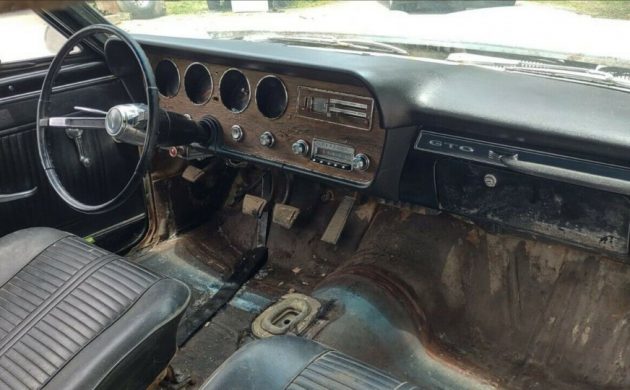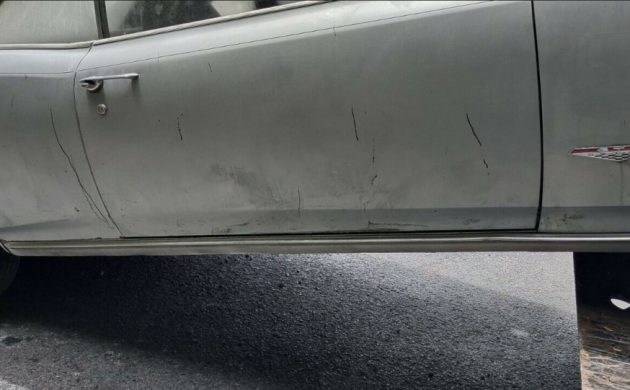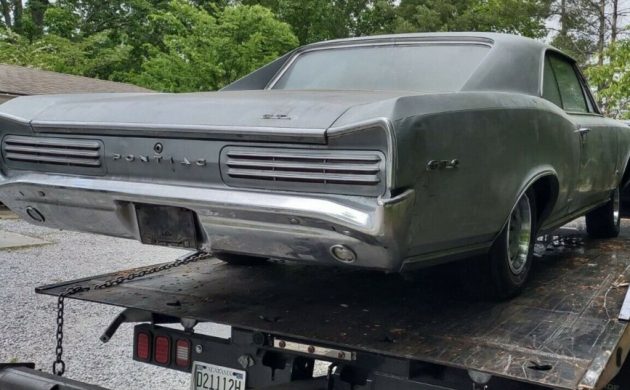For many enthusiasts, 1966 was a landmark year for the Pontiac GTO. It marked the moment when the company elected to make the GTO a standalone model rather than an option package on the Tempest. Those enthusiasts tend to consider the GTO as the spiritual father of the muscle car, with tidy and original examples commanding prices befitting this status. Our feature ’66 GTO is a blank canvas the seller has listed for sale here on eBay with No Reserve. Located in Valley Head, Alabama, the bidding has raced to $7,100. If it remains in that vicinity, it could be one of the most affordable GTO project cars you will find in the current market.
First impressions with this GTO seem relatively positive. The seller claims that the Platinum paint is original, and there’s no doubt the car would benefit from a cosmetic refresh. The panels look reasonably straight, with any defects representing straightforward repairs. That brings us to the subject of rust, and due to the lack of supplied information in the listing, we’re at the mercy of the limited photos to make a few assumptions. There are minor areas visible in some of the lower body extremities, but these appear to be the type that the buyer might address with patches rather than panel replacement. The floors and frame provide further good news for potential buyers. The single underside shot reveals these to wear undercoat, but they look structurally sound. There are no glaring problems, suggesting that the welder won’t work overtime on this classic. The buyer may need to invest in some new trim pieces, but it seems that whipping the panels and paint into shape may not be difficult.
While the carpet is missing, the rest of this GTO’s interior appears complete and unmolested. That’s good news because it is common for items like the factory radio to make way for an aftermarket stereo. That doesn’t mean that the interior needs nothing, but if I were to buy this Pontiac, I would deep clean everything before compiling a shopping list. The faux woodgrain gauge fascia exhibits severe deterioration, but I had no difficulty locating a woodgrain kit for $170. The Rallye gauge lenses are cloudy, and if the buyer has no luck cleaning and polishing these, replacements retail for around $50. The vinyl trim and upholstery looks like it might respond well to a clean, while the rest of the dash and pad look okay.
The seller supplies no engine photos, but this strategy is justified since this classic’s original engine and transmission are a distant memory. That’s a shame because this would have been a potent package in 1966. The engine bay housed the 389ci Tri-Power V8 that churned out 360hp. That power found its way to the rear wheels via a four-speed manual transmission, allowing the GTO to storm the ¼ mile in 14.3 seconds. The loss of major drivetrain components will leave the buyer with choices to make. If they bide their time, locating period-correct components may be possible, although they could also consider more modern alternatives. The faithful path will probably yield a better return when the time comes to part with the GTO, but it could add time and cost to the project that may not be the case with a restomod build.
Some project cars are more affordable than others, and some desirable classics become affordable for a good reason. Such is the case with this 1966 Pontiac GTO. If it retained its numbers-matching drivetrain, I would have expected the bidding to have already reached twice its current figure. That raises the question of which path potential buyers may elect to pursue with this desirable muscle car. If they exhibit some patience, locating a period-correct drivetrain should be possible. While the car still wouldn’t be numbers-matching, that strategy would make a faithful refurbishment viable. However, the buyer may decide to throw caution to the wind and tackle it as a custom or restomod build. Purists may object, but such a path would not involve desecrating an original survivor. A modern fuel-injected V8 would make it a viable and comfortable daily driver while retaining a genuine GTO’s inherent character and performance. It is a route that many may consider, but would you?







Are we sure this is a ’66?, I remember those tailights were introduced in ’67.
Nope. That’s a 66. That’s the first year for the slit tail lamps. The 67 had a more slanted rear fascia.
It is a 66,67 did not have luvers
67 had two rows of two slots
With GTOs, most seem to be higher end restorations ($40K+) or basket cases. This nicely optioned GTO falls in the middle of that continuum. Someone will likely buy this car before the auction ends and I wish it was me.
I had 2 of these, and if I remember correctly, it seemed like the wood surrounding the gauges was actual wood on the 66, and switched to contact paper in 1967……..
Just a thought
This appears to be a decent staring point, advertised as a TriPac (Tri-Power) 4 speed car, although there is no mention of a PHS to document that fact. This could just as easily be a 3 speed base 389, since there is no documentation. Selling any classic Pontiac without PHS makes no sense to me. This has a rather rare for 66 headrest option, which includes the reclining pa4 way flashers, and even the rusted but still there Protect-O-Plate all clearly visible. The only visible body damage is to the left headlight area. This could be a nice builder.
I agree. With PHS so easily attainable, it just doesn’t make sense. But given the tripac reference, I’m guessing he’s not a Pontiac guy and doesn’t know any better. Just some guy that found it and bought it cheap. The protecto plate will indicate engine number and suffix code. Tranny though will only say manual vs auto. No designation between 3 and 4 spd
Kinda looks like the front center took a small hit and was pushed in a bit.
I must be cross-eyed to have missed that!!